The 2023 Mercedes-Benz EQS SUV joins the Tesla Model X and Rivian R1S as the only practical (but impractically expensive) battery electric crossover SUVs that can seat up to seven.
The latest three-row electric crossover comes from an automaker that helped launch the internal combustion engine revolution, instead of just accelerating its demise. There are more to come, including the Kia EV9, and the VinFast VF 9, allegedly. The Mercedes EQB and Tesla Model Y can be equipped with seven seats, but we advise against stacking passengers in like a sleeve of Solo cups.
The Alabama-built EQS SUV feels like the most familiar of the small bunch, though it’s related to the gas-powered GLS in concept only. Its aerodynamic curves, stately cabin, S-Class level appointments, and advanced technology orients the tri-star toward the electric age.
It’s the fourth vehicle for the U.S. in Mercedes’ budding EQ family, and the third and largest Mercedes riding on the brand’s EVA2 dedicated electric platform. It shares much with the EQS liftback—the eventual successor to the S-Class—including a 108.4-kwh battery pack, a base 450+ model with single-motor rear-wheel drive, and a dual-motor all-wheel-drive 580 variant. Unlike the EQS sedan, Mercedes slips in a mid-grade dual-motor 450, but doesn’t offer an AMG version.
2023 Mercedes-Benz EQS SUV
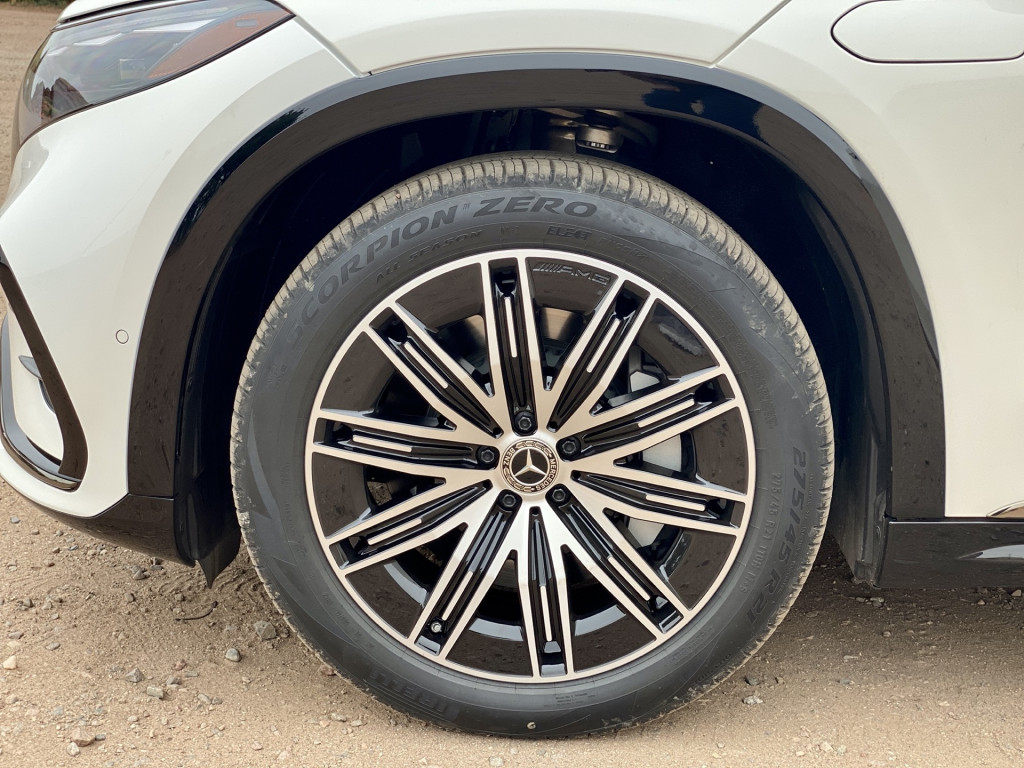
2023 Mercedes-Benz EQS SUV
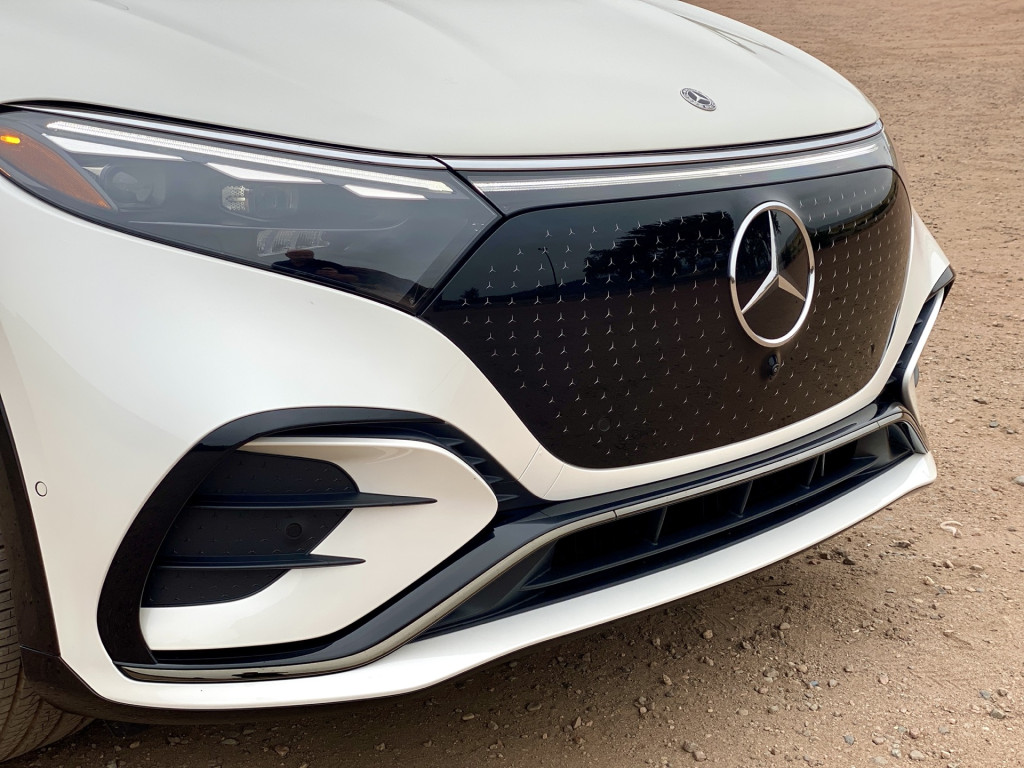
2023 Mercedes-Benz EQS SUV
Big body, good moves
With a standard air suspension and rear-axle steering, all three 2023 Mercedes EQS SUV variants hustle and handle like a vehicle one size smaller than it is.
The base EQS SUV 450+ uses a single 265-kw motor to power the rear wheels. It makes 355 hp and 419 lb-ft of torque, and hits 60 mph in 6.5 seconds. It’s not as quick off the line as some electrics, but it surges ahead when called upon.
The two other variants employ permanent magnet motors on both axles for all-wheel drive. The dual-motor setup in the 450 4Matic makes 355 hp and 590 lb-ft of torque, which helps launch it to 60 mph in 5.8 seconds, according to Mercedes.
The EQS SUV 580 uses two motors at 400 kw to produce 536 hp and 633 lb-ft of torque. It sheds its 6,228 lb curb weight with a shrug on its way to a 0-60 mph time of 4.5 seconds, but what impresses more is how it’s delivered. The smooth linear surge of the EQS 580 stays in character for the three-row SUV instead of slamming occupants back as in twitchier electric cars.
Despite its punchy potential, Mercedes builds the EQS SUV for comfort. The performance SUV in the EQ family arrives next month with the smaller EQE SUV AMG. But with a standard air suspension and adaptive damping that automatically adjusts through a range of four drive modes, the EQS SUV has enough variability to both cushion occupants from road rash but also give drivers more confidence in pushing it than many other three-row SUVs. The lower center of gravity and heavy weight helps it feel stable and planted, while the damping helps fight back against lateral motions so the driver rarely leans into the door.
Rear-axle steering also comes standard, and it turns the rear wheels up to 10 degrees. At speeds above about 35 mph, I couldn’t help but push it on long winding sweepers and feel it cut into fictional apexes with a precision that belies its size. Thick A-pillars chunk up some outward vision, but a suite of advanced driver-assist functions, including automatic emergency braking and blind-spot monitors that detect cars and pedestrians at intersection crossings, offer a third eye.

With the rear-axle steering turning the rear wheels opposite the fronts, it effectively negates the three-point turn. At one cramped trailhead parking area, with parking spots on one side and a fence barrier opposite, I was able to turn 180 degrees without going in reverse, effectively shaving off the ends of the long 126.4-inch wheelbase, which, incidentally is about three inches longer than the wheelbase in the GLS.
That trailhead turnaround led to a brief jaunt off-road beyond an old Rocky Mountain mining town. All-wheel-drive models add an Offroad mode that automatically raises the suspension an inch to make about nine inches of ground clearance. The rear-axle steering helped clip corners dense with trees or brush, and slid the rear end out so the EQS SUV made improbably tight turns. A hill-descent control functioned like an off-road cruise control at speeds up to 11 mph, and an available camera system uses roof-mounted cameras as well as cameras in the front, rear, and side mirrors to project a multitude of views, including one under the front axle. Its off-road capability is only limited by the lack of all-terrain tires offered from the factory.
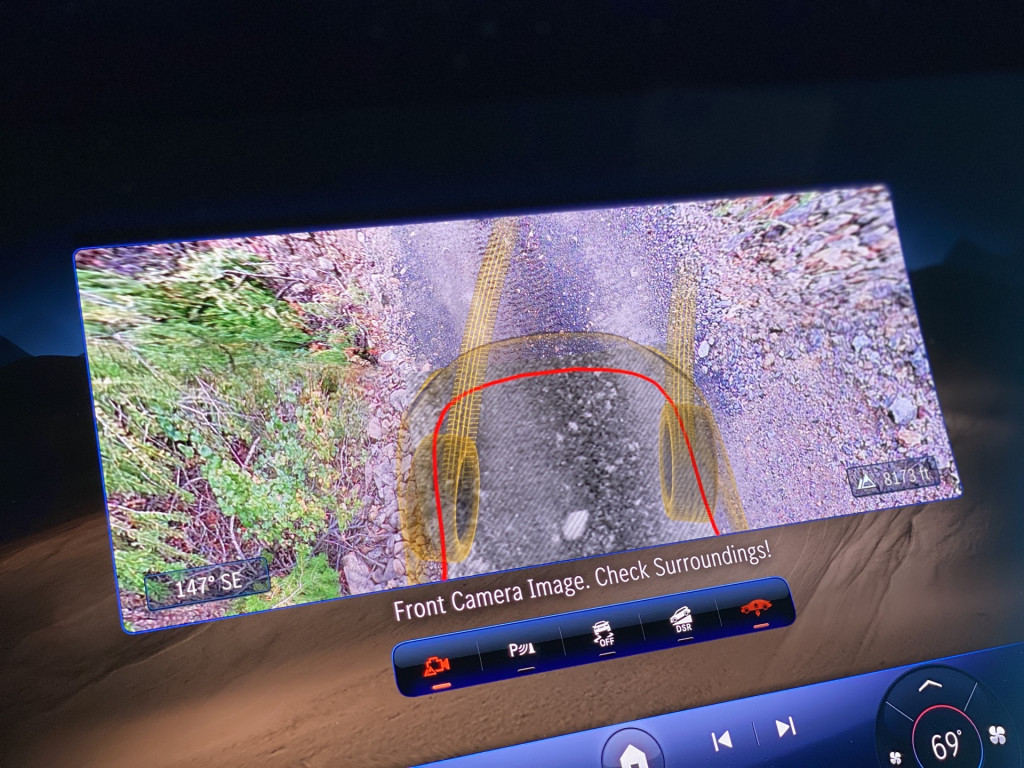
2023 Mercedes-Benz EQS SUV
Regenerative braking
The regenerative braking system is curious. Mercedes calls the settings three plus one, with an Intelligent or automatic function that, when accessed through the paddle shifters, will tell the driver the optimal time to take their foot off the accelerator and the system will adjust the regen based on what lies ahead. Otherwise, the three main settings include a D- coast function that operates similar to a gas car. A default normal D setting gives way to a D+ strong regen mode that can go down to a stop.
There’s nothing unusual about any of that. What’s unusual is that the regen brake setting affects the feel of the accelerator. The D+ mode firms up the accelerator, so changing the regen setting from D to D+ requires more foot pressure on the accelerator to keep it going at the same rate. There’s no technical reason for it, VP of EV architecture at Mercedes-Benz Christoph Starzynski told Green Car Reports. It’s meant to provide consistency in pedal feel between the modes and to remind the driver of the selected mode. It’s easy enough to assimilate to, but it’s still an oddity.
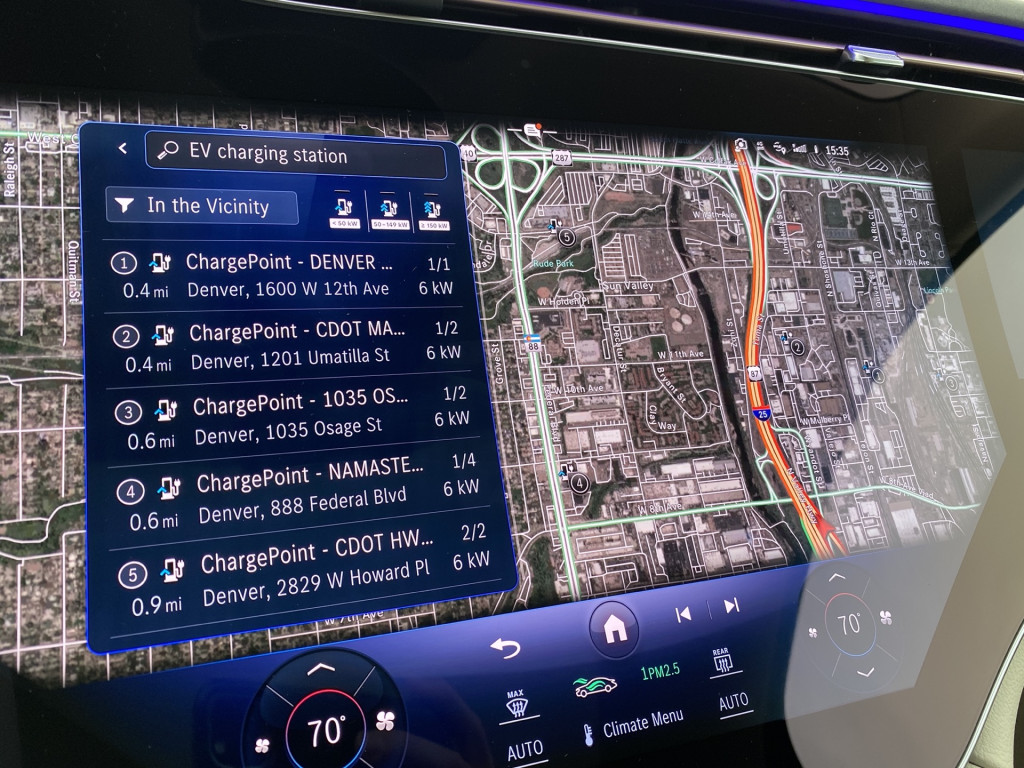
2023 Mercedes-Benz EQS SUV
Charging and efficiency
The EPA hasn’t certified the efficiency of the three-row electric SUV in any motor configuration, but Mercedes pegs the 450+ with a 305-mile range, and estimates 85 MPGe combined and 2.5 miles per kwh. The dual-motor variants have a 285-mile range. Mercedes estimates the 450 4Matic at 79 MPGe combined and 2.3 miles per kwh, while the 580 and its 21-inch wheels reach for 77 MPGe combined, and come just shy of 2.3 miles per kwh.
In terms of efficiency, it splits the difference in a limited sample size. The Tesla Model X with 20-inch stock wheels goes about 3.0 miles per kwh. The Rivian R1S three-row SUV has an efficiency rating of just 2.0 miles per kwh.
The current EQ family has a 400-volt architecture that limits fast-charge times compared to the forthcoming 900-volt architecture expected to debut with the EQG electric G-Wagen. Mercedes rates the battery pack for 200-kw DC fast-charging, and promises at the 110 kw that fast-charge sessions settle into, that the battery can be recharged from 10% to 80% in 31 minutes. On a 240-volt Level 2 outlet, and with a 9.6-kw onboard charger, it takes 12.5 hours to go from 10% to full charge.
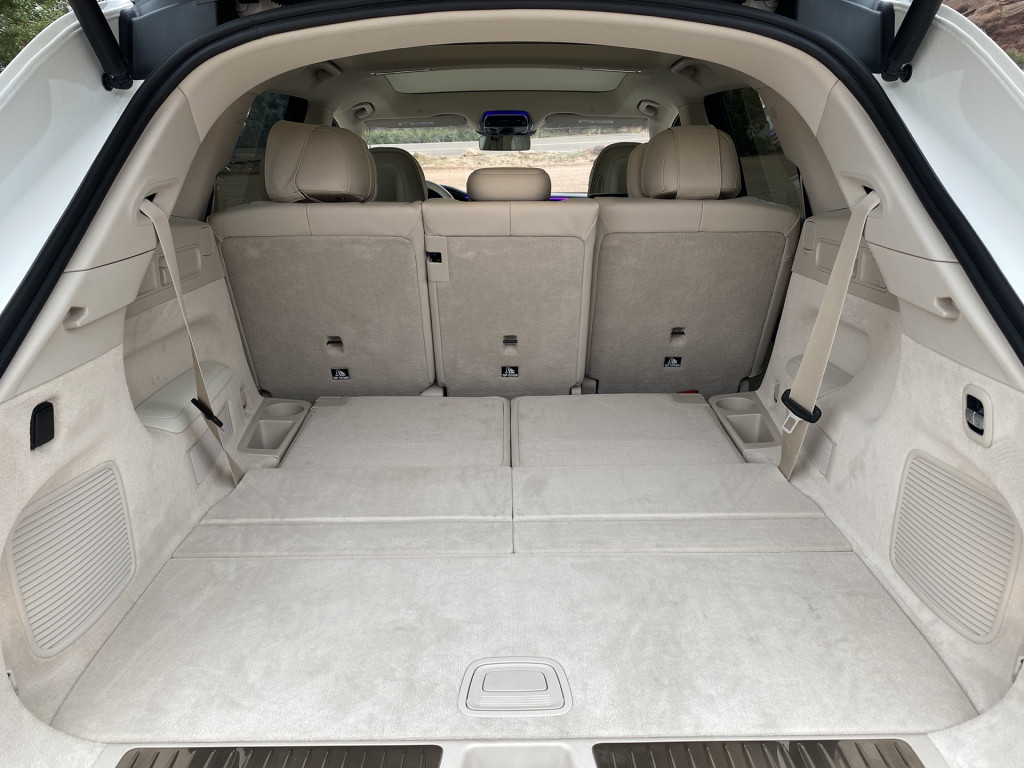
2023 Mercedes-Benz EQS SUV
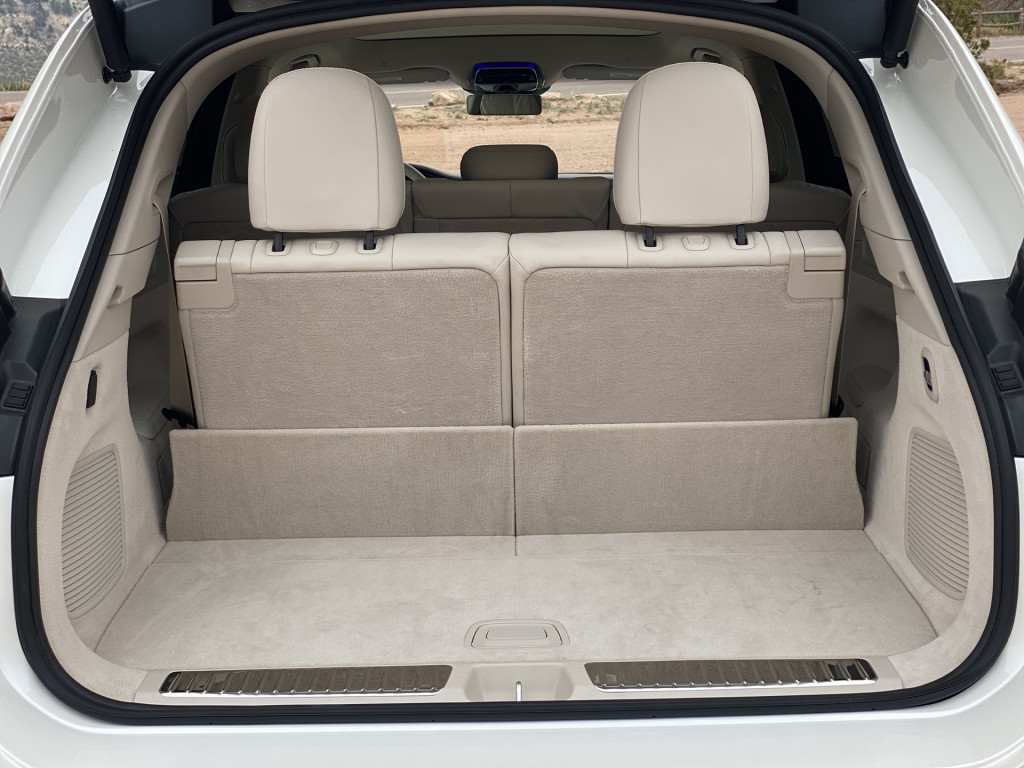
2023 Mercedes-Benz EQS SUV
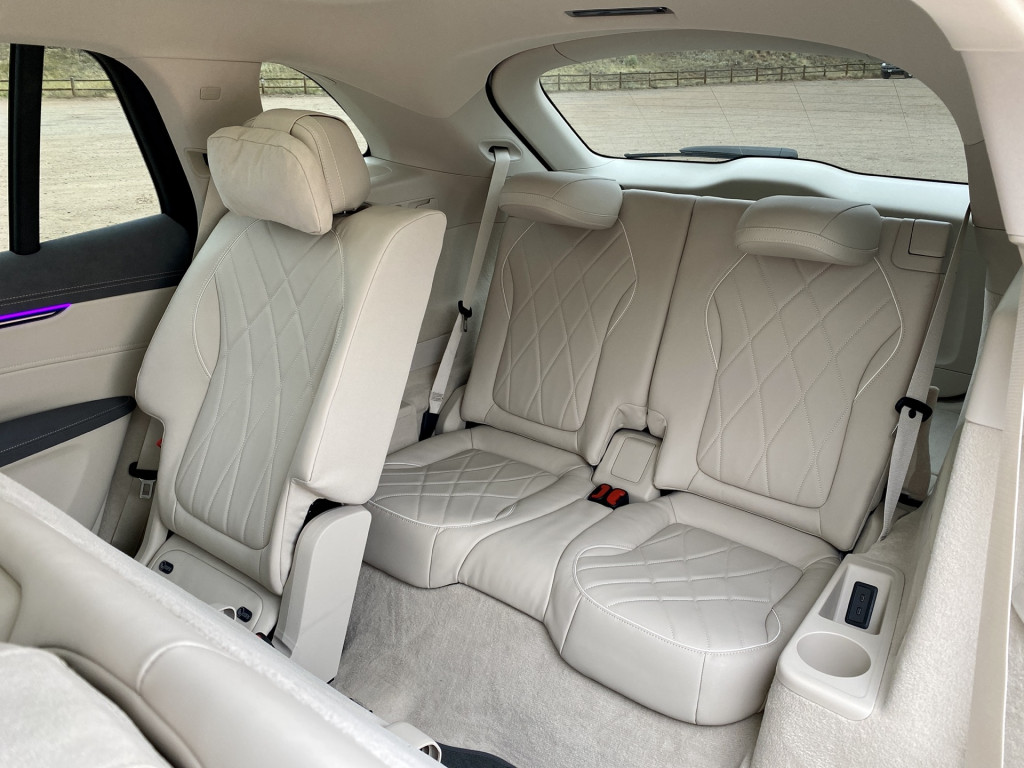
2023 Mercedes-Benz EQS SUV
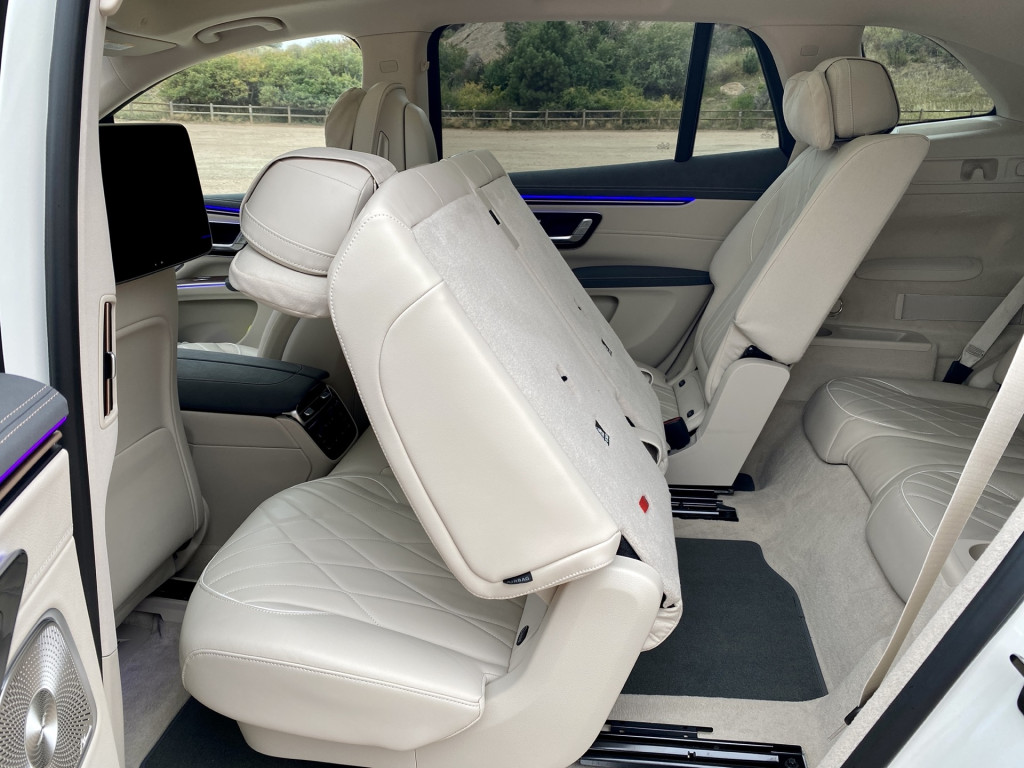
2023 Mercedes-Benz EQS SUV
Mercedes-level luxury, three-row space
With a starting price exceeding $105,000 for the EQ SUV 450+ Premium, Mercedes adorns the cabin with the kind of refinement and sophistication that has defined the brand as much as the internal combustion engine. Power leather seats with heating and cooling come standard up front, and magnolia wood trim lined with laser-etched steel bars or steel Mercedes stars grace the cabin. Small but crucial touches, such as how the leather padded armrests on the doors cushion elbows before the surface curves into wood trim where the wrist bends, assure Mercedes’ peerlessness when it comes to interior finishes. Throw in massaging seats, rapid seat heaters, and 56 inches of screens, and the EQS SUV 580 Pinnacle begins to justify its $133,350 price. Perhaps.
The kaleidoscope of screens known as Hyperscreen consists of a 12.3-inch digital instrument cluster, a 17.7-inch center touchscreen with excellent 3D map graphics and augmented navigation, as well as a 12.3-inch touchscreen for the passenger with internet search and other entertainment options. The last bit is overkill, in my opinion, and would be better served by showcasing the gorgeous wood trim. The lesser models feature a less-distracting layout with a 12.8-inch center touchscreen and no passenger screen.
Five seats come standard, and the second row has power functionality that slides and tilts forward in lockstep with the front seats, so there’s no worry about having to fold headrests or move the front seats. At its lengthiest, there’s more than 41 inches of leg room back there. The optional third row of seats won’t fit larger American adults in comfort, but kids will be fine with their own armrests, cupholders, and USB ports. Fold down the seats with an available power option and the cargo space grows to 31 cubic feet behind row two. A heat pump for the HVAC system won’t arrive until after the EQE SUV launches, but subsequent EQ models can be fitted with it.
The EQS SUV lacks the adventure lifestyle approach of the Rivian R1S, and the tech and performance cachet of the Model X, but it also lacks the X’s packaging complexities. It’s a more familiar, forgiving take on the three-row electric SUV, built on luxurious comfort while not skimping on capability. From an automaker that popularized the internal combustion engine more than a century ago, the EQS SUV is a promising reboot.
Mercedes-Benz paid for airfare and lodging for Green Car Reports to draft this firsthand report.

